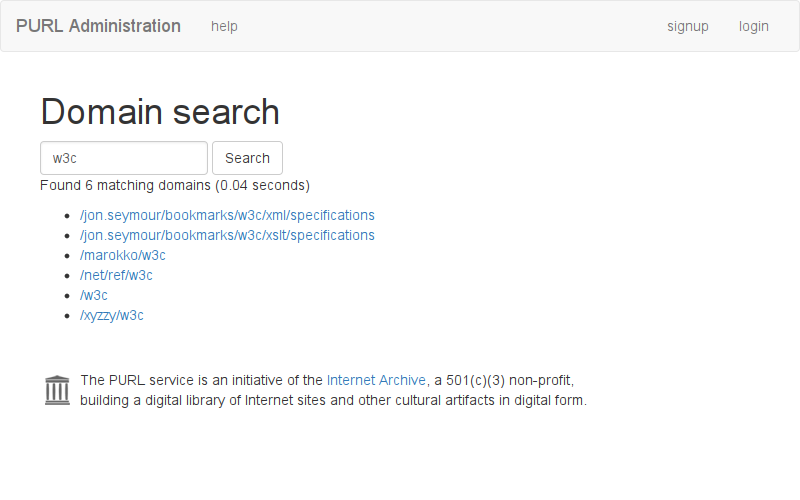PURL help
What is a PURL?
A PURL is a persistent URL, it provides a permanent address to access a resource on the web. When a user retrieves a PURL they will be redirected to the current location of the resource. When an author needs to move a page they can update the PURL to point to the new location.
PURLs with a common prefix are grouped together into domains. Each domain has a single maintainer who can add new PURLs to the domain and make changes to existing PURLs within the domain.
PURL types
Each PURL has a target and status code or type. The target specifies where the PURL redirects to. The type is a status code from HTTP specification. The default PURL type is "302 Found", meaning that the object of the request was found elsewhere. This is the status code that should be used if there is not a reason to use a different one.
A partial PURL is a special type which will match the beginning of a URL. The PURL resolver will match as much of a PURL as it can and append the remainder to the end of the resolved URL. This reduces the need to create multiple PURLs to handle all of the resources that share a common location.
The HTTP status code definitions provides more detail about the different status codes and their meanings.
| PURL Type | Meaning | HTTP Shorthand |
|---|---|---|
| 301 | Moved permanently to a target URL | Moved Permanently |
| 302 | Simple redirection to a target URL | Found |
| 303 | See other URLs (use for Semantic Web resources) | See Other |
| 307 | Temporary redirect to a target URL | Temporary Redirect |
| 404 | Temporarily gone | Not Found |
| 410 | Permanently gone | Gone |
Claiming a PURL domain
The PURL service is now administered by the Internet Archive. If you have any difficulty making changes to your PURLs please contact info@archive.org for assistance.
Administering PURLs
The PURL system is a service of the Internet Archive. To make changes to a PURL users need to have a user account with the Internet Archive.
Search for a PURL
PURLs are grouped into domains, domains can be searched from the home page.

The domain search shows a list of domains that match the search criteria. Each domain links to a domain details page.
Viewing the contents of a PURL domain
The domain details page displays the list of PURLs within the domain. This includes the name, redirect type and target for each PURL.
There is a form that can be used to add new PURLs.

Every PURL has a page that shows information about the PURL including the revision history. There is a link to the edit page.

Users can edit the type of PURL and the target URL.
Version
This is version 1.2.3.
 |
The PURL service is an initiative of the Internet Archive, a 501(c)(3) non-profit, building a digital library of Internet sites and other cultural artifacts in digital form. For help and assistance please email info@archive.org. |